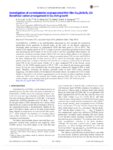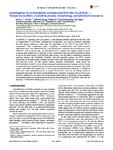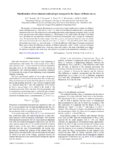|
|
Creator | Title | Description | Subject | Date |
| 126 |
 |
Liu, Feng | Interplay of stress, structure, and stoichiometry in Ge-covered Si(001) | By calculating the evolution of surface energies and surface stress tensors of Ge-covered Si(001) with increasing Ge coverage, we derive the most probable Ge stoichiometry in the subsurface regions beyond 1 monolayer coverage. We compare the calculated surface reconstruction and surface stress at th... | Ge-covered; Si(001); Stress; Structure; Surface stress tensors | 1996-04 |
| 127 |
 |
Liu, Feng | Intrinsic current-voltage properties of nanowires with four-probe scanning tunneling microscopy: a conductance transition of ZnO nanowire | We report intrinsic current-voltage properties of ZnO nanowire measured by a four-tip scanning tunneling microscopy (F-STM). It is found that after bending the nanowire with the F-STM the conductance is reduced by about five orders of magnitude. The cathodoluminescent spectra indicate that the ZnO n... | ZnO nanowire; Four-probe; Four-tip; F-STM; Conductance transition | 2006 |
| 128 |
 |
Scarpulla, Michael | Investigating sputtered Cu2Si1-xSnxS3 (CSTS) for earth abundant thin film photovoltaics | This study investigates the synthesis of chalcopyrite Cu2Si1-xSnxS3 (CSTS) thin films for photovoltaic solar cell absorber layers. Preliminary results indicate that layered sputtering of Cu, Sn, and Si followed by annealing in a sulfur atmosphere at 500⁰C does not provide adequate mixing or sulfu... | | 2010 |
| 129 |
 |
Scarpulla, Michael | Investigation of combinatorial coevaporated thin film Cu 2ZnSnS4 (II): Beneficial cation arrangement in Cu-rich growth | Cu2ZnSn(S,Se)4 (CZTSSe) is an earth-abundant semiconductor with potential for economical photovoltaic power generation at terawatt scales. In this work, we use Raman scattering to investigate phase coexistence in combinatorial CZTS thin films grown at 325 or 470 C. The surface of the samples grown a... | | 2014-01-01 |
| 130 |
 |
Scarpulla, Michael | Investigation of combinatorial coevaporated thin film Cu 2ZnSnS4. I. Temperature effect, crystalline phases, morphology, and photoluminescence | Cu2ZnSnS4 is a promising low-cost, nontoxic, earth-abundant absorber material for thin-film solar cell applications. In this study, combinatorial coevaporation was used to synthesize individual thin-film samples spanning a wide range of compositions at low (325 C) and high (475 C) temperatures. Film... | | 2014-01-01 |
| 131 |
 |
Pugmire, Ronald J. | Investigation of the structural conformation of biphenyl by solid state 13C NMR and quantum chemical NMR shift calculations | The principal values of the 13C chemical-shift tensor (CST) for biphenyl have been determined with the FIREMAT experiment. The internal dihedral angle between the benzene rings in biphenyl is estimated to fall between 10 and 20° on the basis of quantum mechanical calculations of the CST principal v... | Carbon-13; Chemical-shift tensor; biphenyl; FIREMAT | 2001 |
| 132 |
 |
Stringfellow, Gerald B. | Kinetically controlled order/disorder structure in GaInP | A Ga0.52In0.58p order/disorder heterostructure having a band-gap energy difference exceeding 160 meV has been grown by organometallic vapor phase epitaxy. The two layers were grown on a nominally (OOl)-oriented GaAs substrate misoriented by 3° toward the [110] direction in the lattice. The disorder... | Indium phosphides; Gallium Phosphides; Heterojunctions | 1994 |
| 133 |
 |
Liu, Feng | Kinetics of mesa overlayer growth: climbing of adatoms onto the mesa top | We have calculated the energy barriers for an adatom climbing up onto a Pb mesa top either over a facet-facet edge or through a facet-step joint, using a modified embedded atom method. We found that the second process is not only thermodynamically more favorable than the first one but also much fast... | Mesa overlayer growth; Adatoms; Epitaxial growth | 2008 |
| 134 |
 |
Stringfellow, Gerald B. | Kinetics of Te doping in disordering GaInP grown by organometallic vapor phase epitaxy | Te-doped GaInP epitaxial layers were grown by organometallic vapor phase epitaxy in an effort to clarify the Te disordering mechanism. CuPt ordered GaInP is produced under normal growth conditions. The addition of Te has been reported to induce disorder. One suggested mechanism for disordering GaInP... | Crystal growth; Epitaxy; Dynamics | 2001 |
| 135 |
 |
Liu, Feng | Liu et al reply | In our Letter [1], we have demonstrated the plausibility of a structure for ?-cristobalite SiC2 consisting of domains of I Aid symmetry, and provided strong evidence against other proposed models, based on first-principles total energy and lattice dynamics calculations. We are pleased that the Auth... | beta-Cristobalite SiO2; Rigid unit modes; RUM; Transient domain formation | 1993 |
| 136 |
 |
Liu, Feng | Liu et al. reply | In our paper we were alluding to a structural phase transition rather than an order-disorder one. We agree with Blaschko2 that more work needs to be done regarding the statistical mechanics of the hydrogen ordering. This was already acknowledged in our paper when we stated that the model of nonint... | Structural phase transition; Hydrogen ordering; Ising lattice-gas models; Proton glass | 1990 |
| 137 |
 |
Liu, Feng | Local strain-mediated chemical potential control of quantum dot self-organization in heteroepitaxy | From observations of self-assembly of Ge quantum dots directed by substrate morphology, we propose the concept of control of ordering in heteroepitaxy by a local strain-mediated surface chemical potential. Using quite simple lithography, we demonstrate directed quantum dot ordering. The strain part ... | Self-organization; Heteroepitaxy; Chemical potential control; Ge quantum dots | 2004-01 |
| 138 |
 |
Stringfellow, Gerald B. | Long wavelength lattice dynamics for quaternary alloys: GaInPSb and AlGaAsSb | Presents information on a study which investigated the long wavelength lattice dynamics of quaternary alloys. Theory of the random cell isodisplacement model; Secular equation developed; Results and discussion. | Lattice dynamics; Quaternary alloys | 1992 |
| 139 |
 |
Stringfellow, Gerald B.; Sadwick, Laurence P. | Low pressure pyrolysis of alternate phosphorus precursors for chemical beam epitaxial growth of InP and related compounds | The most widely used phosphorous source in chemical beam epitaxy (CBE) is phosphine (PH3). However, because it is highly toxic, alternatives to phosphine have been sought for the growth of phosphorous-containing compounds. We have investigated the pyrolysis rates and reaction products, in low pres... | Chemical Beam Epitaxy; CBE | 1994 |
| 140 |
 |
Scarpulla, Michael | Magnetic cluster phases of Mn-interstitial-free (Ga,Mn)As | We report an investigation of magnetic cluster phases of (Ga,Mn)As of varying dosages formed by Mn ion implantation followed by pulsed-laser melting (II-PLM). A systematic study of zero-field-cooled and field-cooled magnetization along several high-symmetry crystallographic directions reveals the ... | Magnetic cluster phases; Gallium Arsenide; Ferromagnetic semiconductors; Interstitials | 2007 |
| 141 |
 |
Liu, Feng | Magnetism and local order II: self-consistent cluster calculations | The effect of the local environment on the magnetic moment and its convergence to bulk value has been studied self-consistently by using a molecular-cluster model within the framework of spin-density-functional theory. We show that the magnetic moment of the central atom in clusters of 43 Ni atoms a... | Local order; Magnetic moment; Molecular-cluster model; Spin-density-functional theory | 1989-07 |
| 142 |
 |
Liu, Feng | Magnetism and local order: ab initio tight-binding theory | The effects of the local environment on the electronic structure and magnetic moments of Fe, Co, and Ni have been studied by confining these atoms to assume various structural forms such as chains, surfaces, layers, and crystals. The coordination number of the atoms can thus be changed over a wide r... | Local order; Ab-initio tight-binding theory; Magnetic moment; Electronic structure; Fe; Co; Ni | 1989-04 |
| 143 |
 |
Liu, Feng | Magnetism in nanopatterned graphite film | Using first-principles calculations, we show that nanopatterned graphite films (NPGFs) can exhibit magnetism in analogy to graphene-based nanostructures (GBNs). In particular, graphite films with patterned nanoscale triangular holes and channels with zigzag edges all have ferromagnetic ground state... | Nanopatterned graphite; Graphite films; NPGF | 2008 |
| 144 |
 |
Liu, Feng | Magnetism in small vanadium clusters | Using the self-consistent-field molecular-orbital theory and the density-functional approximation, we show that vanadium could become magnetic if its size and dimension were constrained. This is illustrated for vanadium forming clusters with body-centered-cubic (bcc) geometry as well as for linear c... | Vanadium clusters; Molecular-orbital theory; Density-functional approximation; Stoner criterion | 1991-04 |
| 145 |
 |
Liu, Feng | Magnetism of Al-Mn quasicrystals | The effect of symmetry and concentration of Mn on the magnetism of Al-Mn quasicrystals has been investigated through self-consistent density-functional calculations using molecular clusters and supercell band-structure schemes. A single Mn atom surrounded by 54 Al atoms in an icosahedral or a cuboct... | Al-Mn quasicrystals; Self-consistent; Density-functional calculations | 1993-07 |
| 146 |
 |
Liu, Feng | Magnetization on rough ferromagnetic surfaces | Using Ising-model Monte Carlo simulations, we show a strong dependence of surface magnetization on surface roughness. On ferromagnetic surfaces with spin-exchange coupling larger than that of the bulk, the surface magnetic ordering temperature decreases toward the bulk Curie temperature with incre... | Ferromagnetic surfaces; Surface magnetization | 2000-11 |
| 147 |
 |
Liu, Feng | Magnetization on vicinal ferromagnetic surfaces | Using Ising model Monte Carlo simulations, we show a strong dependence of surface magnetization on surface miscut angle. For ferromagnetic surfaces, when surface spin exchange coupling is larger than that of the bulk, the surface magnetic ordering temperature decreases, toward the bulk Curie tempera... | Vicinal ferromagnetic surfaces; Surface magnetization; Surface miscut angle | 1997 |
| 148 |
 |
Scarpulla, Michael | Magnetocrystalline anisotropy and magnetization reversal in Ga1-xMnxP synthesized by ion implantation and pulsed-laser melting | We report the observation of ferromagnetic resonance (FMR) and the determination of the magnetocrystalline anisotropy in (100)-oriented single-crystalline thin film samples of Ga1−xMnxP with x=0.042. The contributions to the magnetic anisotropy were determined by measuring the angular and the te... | Magnetocrystalline anisotropy; GaMnAs; Gallium arsenide | 2007-06 |
| 149 |
 |
Liu, Feng | Making a field effect transistor on a single graphene nanoribbon by selective doping | Using first-principles electronic structure calculations, we show a metal-semiconductor transition of a metallic graphene nanoribbon with zigzag edges induced by substitutional doping of nitrogen or boron atoms at the edges. A field effect transistor consisting of a metal-semiconductor-metal junctio... | Graphene nanoribbon; Selective doping | 2007 |
| 150 |
 |
Tiwari, Ashutosh | Manifestation of two-channel nonlocal spin transport in the shapes of Hanle curves | The dynamics of charge-density fluctuations in a system of two tunnel-coupled wires contains two diffusion modes with dispersion iω = Dq2 and iω = Dq2 + 2τt, where D is the diffusion coefficient and τt is the tunneling time between the wires. The dispersion of corresponding spin-density modes de... | | 2014-01-01 |

























